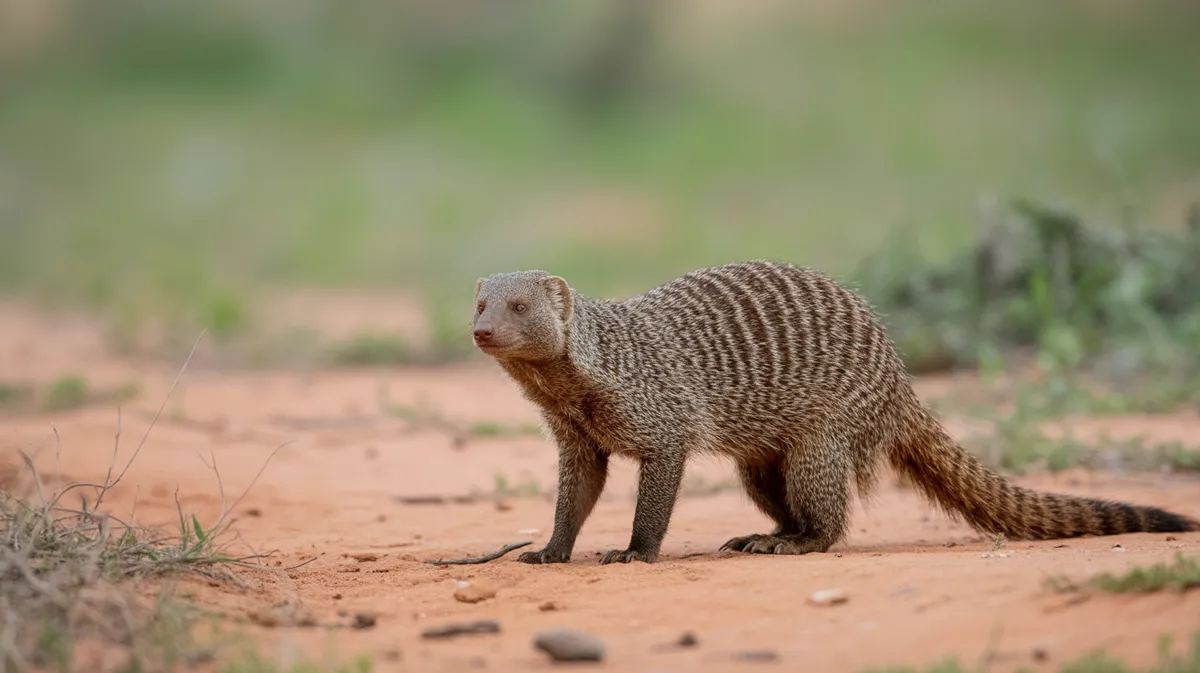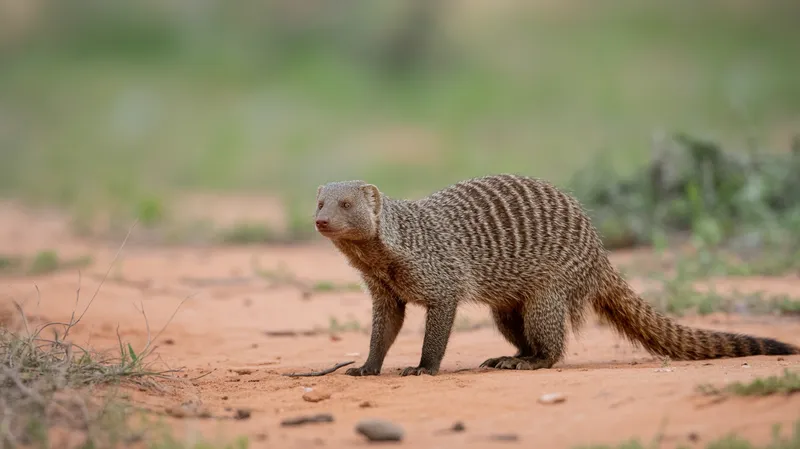
Banded Mongoose
Mungos mungo

Meet the Banded Mongoose
The banded mongoose is a small, highly social mammal native to sub-Saharan Africa, easily recognized by its dark horizontal bands across a gray-brown back. Living in large groups, these animals are known for their cooperative behaviors, including babysitting and foraging together. Banded mongooses are skilled hunters, feeding on insects, small vertebrates, and even eggs, often using clever techniques like smashing eggs against rocks. Adaptable and resilient, they thrive in a variety of habitats, frequently seen in savannas, grasslands, and open forests.
Classification
Mammal
Habitat
Savanna and grassland
Diet
Omnivore
Lifespan
7-12 years
Conservation
Least Concern
Weight
1.5–2.5 kg
📖Fascinating Facts
Super Social
Banded mongooses live in colonies that can number up to 40 individuals, working together for protection and food.
Egg Smashers
They use their strong forelegs and clever tactics to break open eggs by hurling them against rocks.
Snake Fighters
Banded mongooses sometimes hunt or defend themselves from venomous snakes, exhibiting partial immunity to certain venoms.
📋Detailed Description
The banded mongoose (Mungos mungo) is a robust, small carnivoran, typically measuring 30–45 cm in body length with a tail of 15–30 cm, and weighing between 1.5 and 2.25 kg. Its coarse, grizzled fur is grayish-brown, marked by 10–15 distinct dark brown to black horizontal bands across the back, which are unique to each individual. The head is wedge-shaped with a pointed snout, small rounded ears, and short limbs adapted for digging. Banded mongooses are diurnal and highly social, living in cohesive troops that can number from 10 up to 40 individuals, though supergroups of over 70 have been recorded. Their societies are characterized by cooperative behaviors such as communal care of young, coordinated foraging, and mutual grooming. Communication is complex, involving a range of vocalizations, scent marking, and body postures. They are opportunistic omnivores, feeding primarily on insects (especially beetles and larvae), millipedes, and other invertebrates, but also consuming small vertebrates, eggs, fruits, and roots. Banded mongooses are known for their intelligence and problem-solving abilities, including using tools—such as rocks—to crack open eggs or hard-shelled prey. They occupy a variety of habitats, from open savannas and grasslands to woodland edges, and frequently use abandoned termite mounds or self-dug burrows as communal dens. Their adaptability and social structure have contributed to their success across a wide range of sub-Saharan Africa.
💡 Did you know?
Banded mongooses have been observed using tools—breaking open eggs by throwing them against hard surfaces, showcasing impressive problem-solving skills.
🔬Research & Sources
Wikipedia Summary
The banded mongoose is a mongoose species native from the Sahel to Southern Africa. It lives in savannas, open forests and grasslands and feeds primarily on beetles and millipedes. Mongooses use various types of dens for shelter including termite mounds. While most mongoose species live solitary lives, the banded mongoose live in colonies with a complex social structure.
Last Modified: 5/24/2025
🎭Behavior & Social Structure
Banded mongooses exhibit a highly cooperative and coordinated social system. Troops forage together in close-knit groups, often moving in a loose line and communicating with constant contact calls to maintain group cohesion. Foraging is typically done by digging and overturning debris in search of prey, with individuals using their strong forelimbs and sensitive noses. They display remarkable teamwork, such as sentinel behavior where one or more individuals stand guard for predators while others feed. Aggression within groups is rare, but intergroup encounters can be highly violent, sometimes resulting in fatalities. Social hierarchies are relatively egalitarian compared to other mongoose species, with multiple females breeding and communal care of pups. Daily routines involve leaving the den at sunrise, foraging throughout the day with rest periods, and returning to the den before dusk. Banded mongooses are also known for their play behavior, which is important in social bonding and skill development.
👶Reproduction & Life Cycle
Banded mongooses are unusual among mammals in that most females in a group come into estrus and give birth synchronously, often within a few days of each other. Breeding occurs year-round but peaks during the rainy season when food is abundant. Gestation lasts about 60–70 days, after which litters of 2–6 pups (average 4) are born in the communal den. Alloparental care is a hallmark of the species: non-breeding adults, especially males, act as 'escorts' to specific pups, providing food, protection, and grooming. Pups are weaned at around 4–6 weeks and begin foraging with the group shortly after. Sexual maturity is reached at about 1 year of age. The high degree of reproductive synchrony and communal care reduces infanticide and increases pup survival rates.
🛡️Adaptations & Survival
The banded mongoose possesses several physical and behavioral adaptations for survival. Its strong, curved claws and robust forelimbs are specialized for digging and manipulating prey. The coarse, banded fur provides camouflage in dappled light and grassland environments. Social living offers protection against predators such as birds of prey, snakes, and large carnivores, as well as increased foraging efficiency. Their acute sense of smell aids in locating hidden prey. Behavioral flexibility, including tool use (e.g., using rocks to break eggs), allows them to exploit a wide variety of food sources. The use of communal dens, often in termite mounds, provides shelter from predators and extreme weather. Synchronous breeding and communal pup care are evolutionary strategies that enhance offspring survival in unpredictable environments.
📚Research Sources
🎨Cultural Significance
Banded mongooses are not as prominent in African folklore as some other mongoose species, but they are sometimes regarded as beneficial animals due to their role in controlling insect and small vertebrate pests. In some regions, they are associated with cleanliness and industriousness because of their foraging habits. There are occasional reports of their use in traditional medicine, though this is not widespread. Their social behavior and boldness have made them a subject of interest in wildlife documentaries and ecological studies, contributing to their recognition in popular culture.
🔬Recent Research & Discoveries
Recent research on banded mongooses has focused on their complex social structure, cooperative breeding, and the evolutionary drivers of reproductive synchrony. Long-term field studies, particularly in Uganda and Botswana, have revealed insights into their conflict resolution, intergroup warfare, and the role of kinship in group dynamics. Genetic studies have shown high levels of relatedness within groups, supporting theories of cooperative breeding. Ongoing research is examining the impacts of disease transmission, especially rabies, in populations living near human settlements. Studies on vocal communication have demonstrated that banded mongooses use a rich repertoire of calls, some of which convey individual identity and intent. Their adaptability to human-modified environments is also a topic of ecological and conservation interest.
🎥Wildlife Videos

Banded Mongoose | Amazing Animals
About Amazing Animals: Amazing Animals is a series that profiles a different animal in each episode. These short, one-minute ...
Nat Geo Kids

Army Of Tiny Mongoose Fight To Survive Against Apex Predators | Bandits Of Selous | Real Wild
In this wildlife documentary, a brave pack of Mongooses is showcased over the span of one year in their fight to survive amidst all ...
Real Wild

Mongoose: The Story Of An Unlikely Predator | Our World
A cobra's venom can kill a man in minutes, yet a pack of banded mongooses will mob one with confidence. The Martial eagle can ...
Our World

Be The Creature: Banded Mongoose - Season 1 |Full Episode|
FC Kratt Brothers 🇧🇷

This Warthog took a trip to the Mongoose Spa | Banded Brothers - BBC
Banded Brothers | Series 1 Episode 1 | BBC #BBC #BandedBrothers #MongooseSpa.
BBC

How a Mongoose Gang Fights Off Snakes in the Wild | Our World
TALES FROM THE WILD takes some of the most spectacular wildlife moments ever caught on film from the Survival Archive and ...
Our World
🌍Habitat Information
The Banded Mongoose typically inhabits Savanna and grassland environments. Banded Mongooses have adapted to their environments with specialized features and behaviors.
Primary Habitat:
Savanna and grassland
More detailed habitat information will be available soon.
🛡️Conservation Status
The Banded Mongoose is currently classified as Least Concern. Conservation efforts are crucial for preserving this species for future generations.
Common Threats:
- 🏠Habitat loss and fragmentation
- 🌡️Climate change impacts
- 🎯Hunting and poaching
- 🏭Human-wildlife conflict
⚠️Threats & Conservation Challenges
Currently, the banded mongoose is classified as Least Concern by the IUCN, with stable populations across much of its range. However, local threats include habitat loss due to agricultural expansion, urbanization, and deforestation. In some areas, they are persecuted as pests or carriers of disease, notably rabies and tuberculosis, which can be transmitted to livestock and humans. Road mortality and predation by domestic dogs also pose risks. Despite these challenges, their adaptability and generalist diet have allowed them to persist in human-altered landscapes. Long-term conservation concerns include the potential for disease outbreaks and the effects of habitat fragmentation on genetic diversity and social structure.
🔬Scientific Classification
Scientific Name
Mungos mungo
Classification Hierarchy
🔍 About Taxonomic Classification
Taxonomic classification is a hierarchical system used by scientists to classify and organize living organisms based on shared characteristics and evolutionary relationships.
The system moves from broad categories (Kingdom) to increasingly specific ones, with each animal's scientific name typically consisting of its Genus and species.
📝Community Notes
Share your observations and insights about the Banded Mongoose with our community of wildlife enthusiasts.
Join Our Community
Sign in to share your observations and connect with fellow wildlife enthusiasts.
Sign In to ContributeNo community notes yet
Be the first to share your observations about the Banded Mongoose!
Explore Banded Mongoose
Select a tab above to learn more about this amazing animal.
📸Photo Gallery
No photos available for this animal yet.
🌟Discover More Wildlife
Continue your journey of discovery with more fascinating animals from our database
